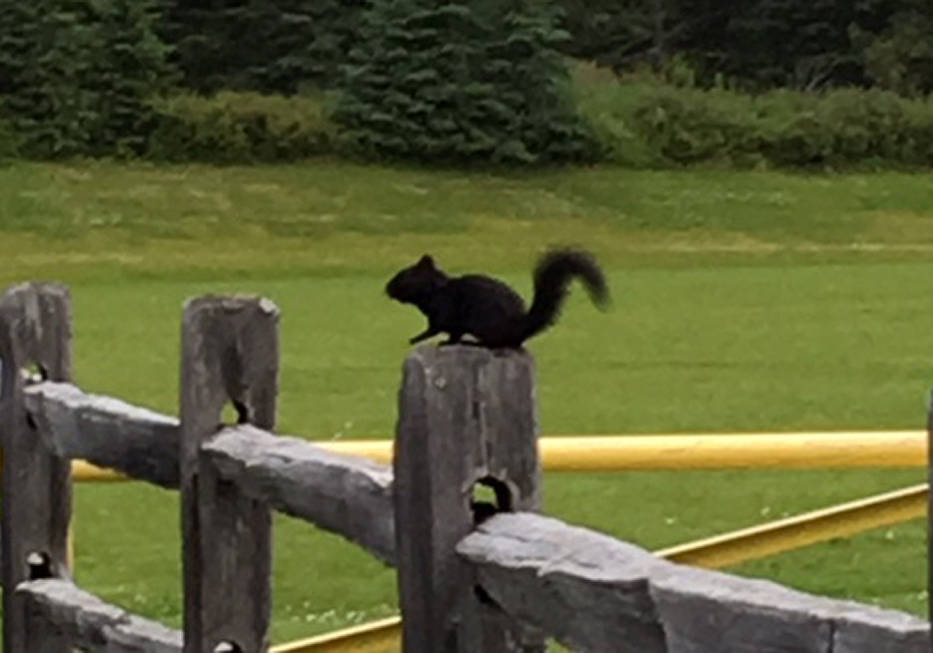A black squirrel is hanging around this summer. I became aware of this strange little creature when a picture from the Northern Peninsula Recreation Center popped onto my Facebook feed. I had never seen anything like it. We only have two species of tree-dwelling (arboreal) squirrels in Alaska: the American red squirrel and the northern flying squirrel.
Here on the Kenai Peninsula, that number drops to one because flying squirrels have not made it across the isthmus to populate our area. Our red squirrels are also influenced by the peninsular geography. Kenai red squirrels are isolated enough to qualify as a unique subspecies (Tamiasciuris hudsonicus kenaiensis), one of 25 subspecies distributed across North America.
I would guess that almost everyone living on the peninsula has seen a red squirrel. They are quite conspicuous or even obnoxiously loud as they defend their territories. Red squirrels cache piles of spruce cones and chatter alarm calls when bothered by intruders. They are agile climbers and easily observed racing across tree branches.
Red squirrels are also easy to identify. They are a small as compared to other squirrels (though we don’t have to distinguish them from other species). The back-side of their bodies is reddish brown to olive-grey. Their bellies are white to buffy colored and they have a distinct white eye ring. In the breeding season, red squirrels have a black racing stripe that separates their red and white coloring. So what is going on with the black squirrel? The answer is melanism.
Melanism refers to mammals that are born with black or very dark brown coats. This phenomenon occurs in many squirrel species. For example, black individuals have been documented in Arctic ground squirrels and yellow-bellied marmots. Melanism has a genetic basis. A genetic mutation has been identified in grey squirrels whereby melanistic grey squirrels are missing a piece of gene that is involved in producing the pigments that color fur. They cannot turn off production of those pigments that make black fur to make white or orange fur. Grey squirrels that inherit the mutated gene from one parent are dark and those who inherit the mutation from both parents are black. Aside from the genetic mutation that produces dark fur, a melanistic animal can still interact and mate with other squirrels.
Genetic mutations occur, but they only become common in a population if they give the individuals that have them an advantage. Squirrels with black fur may be able to absorb more heat from the sun giving them a thermal advantage in cold environments. Black fur could make an animal less likely to be spotted by predators in a dark forest canopy.
Melanism is taking root in populations of grey squirrels. Black grey squirrels are common to see in Chicago. Grey squirrels are from North America, but invaded Britain in the late 19th century as squirrels escaped the cages of collectors. The first melanistic grey squirrel was spotted in Bedfordshire County in 1912. Within the past century, black squirrels have become common in Bedfordshire and have shown up in a wider geographic area.
Melanism is reported to be relatively rare in American red squirrels. Dark individuals have been documented in New York, Yukon and Nova Scotia, but melanism has not become common in these populations. The scientists reporting on the melanistic red squirrel in Nova Scotia speculate that perhaps being dark is not advantageous because their bodies are too small to hold much heat and red squirrels deal with cold winters by restricting activity and staying under the snow.
I’ve been asking everyone I run into if they have seen black squirrels on the Kenai. Besides the squirrel at the Rec Center in Nikiski, I’ve heard credible reports of a black squirrel on Marathon Road in Kenai and at the Kenai golf course. Perhaps we will see our local population of black squirrels increase or perhaps they will blink out.
Dr. Magness is the landscape ecologist at Kenai National Wildlife Refuge. Find more information about the Refuge athttp://www.fws.gov/refuge/kenai/ or http://www.facebook.com/kenainationalwildliferefuge.

